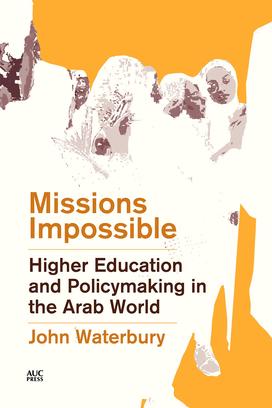John Waterbury ’61 on Higher Education Policy as Tool for Regime Stability in Middle East
The book: Missions Impossible: Higher Education and Policymaking in the Arab World (American University in Cairo Press) takes an in-depth look at higher education policymaking in the Middle East. While many institutions of high education around the suffer from lack of funding or in-demand skills, John Waterbury ’61 argues that these problems and more are especially acute in the Middle East, where higher education policy is closely linked to regime stability.
Caught between stifling universities, and therefore social and economic growth, or unleashing universities to grow into an uncontrollable force, Middle Eastern regimes are hard-pressed to find a solution that guarantees regime survival. Through an investigation of the impacts higher education policy has had in the region, Waterbury contends that the compromise policies these regimes have reached are ultimately unsustainable.

Opening lines: A premise of this study, so widely held that I doubt it would arouse any dissent, is that Arab higher education has been and remains in a state of structural crisis. This has been documented at fairly high altitude since 2002 in various Arab Human Development Reports, especially those of 2003 on “Building a Knowledge Society” and 2009 on “Toward Productive Intercommunication for Knowledge.” Surveying all levels of education, the World Bank study of 2008, The Road Not Traveled: Education Reform in the Middle East and North Africa, is equally critical. Finally, the most focused study, although gentler in its critique, is Munir Bashshur’s 2004 Higher Education in the Arab States.
As I shall examine in what follows, there may be nothing peculiarly ‘Arab’ about this crisis. I suspect that many developing countries that committed themselves to democratizing higher education find themselves in similar situations. Indeed, it came as something of a surprise to me that there are no problems in higher education unique to the Middle East and North Africa region or even to developing countries. The problems Arab universities face and the pathologies with which they grapple differ in degree but not in kind from those in other countries. Let me mention just a few here:
- Crises in public financing of higher education, as real for the United States (US) or the United Kingdom (UK) as for Egypt or Morocco.
- The erosion of the academic profession or what I call the myth of the full-time professor. Adjuncts in the U.S. have become the indispensable cogs of higher education just as the nominally ‘full-time’ professor in the Arab world has had to seek employment outside academia to make ends meet.
- The tendency for universities to reinforce class privilege rather than overcome it is ubiquitous.
- Dropout rates are a universal problem. Argentina has been a world leader in this respect.
However, to the extent that these problems have their roots in the political institutions of the region, there may be something peculiarly Arab about the problem.
There are two broad levels that require examination. The first is national ‘strategy’ and goals, in the current instance, in the higher education sector. Strategies evolve, so we need to know where the sector has been in order to understand priorities for the future. The second level involves governance structures, including how leadership is selected and performance monitored (accountability), and the incentives that both principals and agents have to achieve any particular set of goals. Obviously, a big part of the governance picture is finances and resources. An equally big part is the effective degree of autonomy the institution enjoys.
It is safe to say that the ‘crisis’ has been created at both levels—national strategy and institutional governance—and to address it will require changes at both levels. Much of the policy literature mentioned above and to which we shall return is prescriptive. It says more about what should be done than how to do it, given the political context.
One way to understand what is possible is to select cases of successful reform, islands of excellence, or at least cases in which palpable progress is being made. For example, Cadi Ayyad University (CAU) in Morocco or Suez Canal University in Egypt may have been able to make progress where their older and more illustrious sisters, like Mohammed V University or Cairo University seem mired in inertial practices. The problem here is that outside the private sector there may be very few such success stories.
Or one could look at success in other regions altogether. One example might be the National University of Singapore (NUS) or perhaps the Indian Institutes of Technology. We shall look further on at the NUS and also at Sharif University of Technology (SUT) in the Islamic Republic of Iran.
Whether one selects for success or on the basis of some other criteria, I think we may best understand basic problems by hearing the agents themselves: the rectors and chancellors, the deans and vice presidents. We may understand effective governance, incentives, and accountability best through their eyes. It is also the medium of direct interviews with which I am most comfortable and experienced…
We are joining an ongoing debate on the fundamental nature of education in society, who benefits from it, and who pays for it. One school argues that education at all levels enhances the individual earnings of its products and that they should therefore pay for it out of taxes on their enhanced incomes. In this view, education is a private good that generates an income stream (see Cooper, 2017).
At the opposite end of the spectrum are those who see education as a right, the violation of which will harm society as a whole. Education is a public good that provides benefits for all of society (even to those who drop out of high school or never go to university). The benefits are the provision of actors fit to be responsible, informed citizens as well as trained participants in a dynamic workforce and a healthy economy. Given that many educational institutions enjoy tax-free status and benefit from public land, and given that taxpayers fund public higher education from which, in most societies, many adults do not benefit, the preponderant view seems to be that education is a public good (see Anomaly, 2018).
One final observation: the giant national universities will for many decades to come take on the heavy lifting of higher education in the Arab world. They educate in the hundreds of thousands, and their graduates often swamp the civil service and public enterprise sector. They are underfinanced (except in some of the petroleum-exporting states) but, at the same time, represent huge sunk investments that cannot be written off nor easily broken up into more manageable pieces. Is there any vision for the future either at the level of the principals or at the level of the agents? Are there ‘disruptive innovations’ on the horizon that might blow the old public ships out of the water? We will engage these questions throughout the chapters that follow.
Review: "This is the most incisive and informative analysis of the crisis of higher education in the Arab world I have seen so far. Waterbury uses his firsthand knowledge of the sector and his in-depth knowledge of the political economy of the region to produce an astute and comprehensive analysis of the pathologies of the higher education systems in the Arab world and the available options for reform."—Ragui Assaad, University of Minnesota












No responses yet